
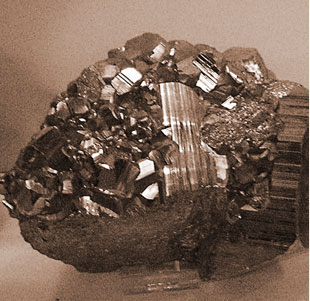 |
*Magical town of the mountain spirit Our town and its surroundings can be explored by hiking the award-winning Magical Trail of the Mountain Spirit. This field game, a hiking trail, fun, history and nature all in one, enjoys enormous popularity among Szklarska Poręba visitors. In the Karkonosze Museum, you can see a permanent exhibition dedicated to Rzepior. Karkonosz is a living legend that combines the contemporary town of Szklarska Poręba with its history. Mineralogical Museum Szklarska Poreba aspires to be the Mineralogical Capital of Poland, and each year the mineralogical offer expands. More than 50 minerals commonly occurring in the Karkonosze Mountains and the Jizera Mountains have been classified, and many of them have properties of precious and semi-precious stones. True earth treasures can be found without any difficulty in mountain brooks and rocks even today. In 1999, in Szklarska Poręba, the Sudeten Walloon Brotherhood was founded to bring together people who wanted to continue Walloon traditions, promoting the town as the Mineralogical Capital of Poland. The Old Cottage Walloon is the seat of the Brotherhood. In front of the Mineralogical Museum building there are trunks of the Carboniferous Forest, and among the museum exhibits you can find rocks and minerals from all over the world, a rich collection of the Karkonosze Mountains minerals, two dinosaur eggs, 7 dinosaur nests, a meteorite; in total, there are over 3 thousand specimens. In addition, a 14-carat black diamond in a natural kimberlite rock has been exhibited for 3 years now. In Szklarska Poręba, there is also the JUNA Earth Museum and the Karczma Głodowa inn. Initially, this place served as a watchtower by the Czech Path, one of the oldest known trails leading from through the range of the Karkonosze Mountains. A travelers inn, now the Karczma Głodowa, was built by the watchtower; the inn's name is associated with the construction of the so-called hunger road from Piechowice through Szklarska Poręba to Harrachov. Currently, the Earth Museum is located there. |
||
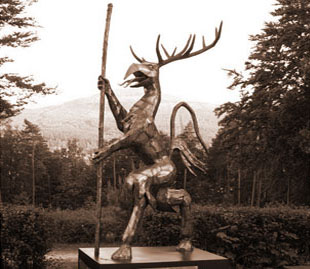 |
The Mountain Spirit In the Radiowa Trójka Square (Skwer Radiowej Trójki), in the town centre, there is the monument of the Mountain Spirit made according to the model of the oldest image by the German cartographer Martin Helwig dating back to 1561. The "time capsule" rests at the foot of the monument. It was solemnly placed there on 18 November 2010. Liczyrzepa will protect it for the next fifty years. Only after 50 years, on the centenary of granting municipal rights to our city, the capsule will be opened by the next generation of the Szklarska Poręba residents. The capsule contains a message to the future generations, the documents describing our present and symbols that we are currently using, such as: the town's coat of arms, Polish coins, the Walloon Star with an amethyst, certificate of the Polish Mineralogical Capital, a medal for Participation in the Bieg Piastów race, urban ducats, 1 silver Walloon AuRun, as well as a sealed instruction showing the location of the starting point of the trail, at the end of which 12 silver AuRuns can be found in 2060. |
||
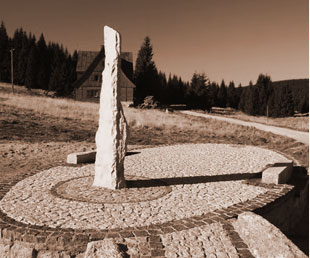 |
Astro path in the Jizera Mountains An exceptional attraction for tourists and admirers of the night starry sky was created in Szklarska Poreba-Jakuszyce by the ORLE Tourist Station. As part of the Izera Dark-Sky Park, an "astro path" – the model of the solar system was built. Each of its elements is made of a different type of rock originating from Lower Silesia. The path is also a lesson of astronomy and geology. According to the authors of the idea published at Izera-Darsky.eu, the characteristic of the Jizera educational path is its location in the mountains. |
||
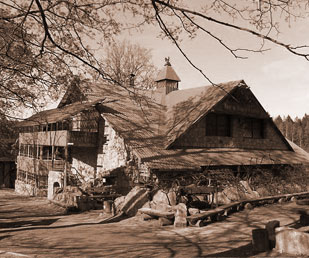 |
The Old Walloon Hut The Old Walloon Master – Juliusz Naumowicz, tenaciously pursuing his vision of the Walloon enclave on the land of Szkarska Poręba, completed the construction of the Celtic Room and the Karkonosze Herbs Drying House; thus the Gar Mocy was elevated two floors up. The oldest and most mysterious traditions of the region of the Karkonosze Mountains were concentrated in one place. The Walloons are derived directly from the Celts, who laid the foundations of the European civilization. To this day, the arts and secret knowledge of the Druids arouse strong emotions. The Walloons used the Celts' knowledge in geological penetration and mining of the land treasures. For almost 200 years, laboratory technicians assistants discovered for the Europeans another treasure of our mountains – the herbs of the Karkonosze Mountains, and potions and ointments prepared from those herbs were considered a panaceum for all ailments. Particularly noteworthy is the fact that the entire building was adapted for the people with disabilities. |
||
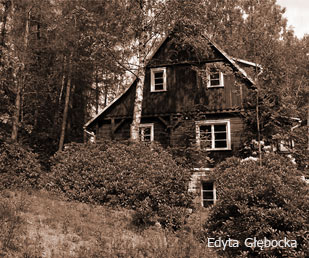 |
The Vlastimil Hofman House The Vlastimil Hofman House has been operating virtually intact since the artist's death. The interiors of the seemingly tiny cottage hide the master's studio, where his easels still stand and brushes and tubes of paint lie on the table. The atmosphere of the place, as the current host, Mr. Waclaw Jędrzejczak claims, is still filled with the artist's spirit, which can't be experienced in any museum. Vlastimil Hofman (1881-1970) – called by Jan Sztaudynger the "inner glow painter", known in Poland and abroad artist: a painter, a poet, a student of Stanisławski, Wyczółkowski and Jacek Malczewski. In 1947, he moved from Cracow to Szklarska Poręba at the instigation of Sztaudynger, where he lived with his wife in a small house at ul. Średnia. Hofman integrated very much with the local community; he painted many portraits and small images for the residents. The local Franciscan Fathers were the audience of his contemporary works. His works decorate private homes and local churches. The "Vlastimilówka" Hofman House – soon became a meeting place for the local arts community. After the painter's death, pursuant to the terms of the will of the deceased, the house with all the equipment was passed to Wacław Jędrzejczak. The current host makes available to visitors the painter's studio and a little guest room with paintings. |
||
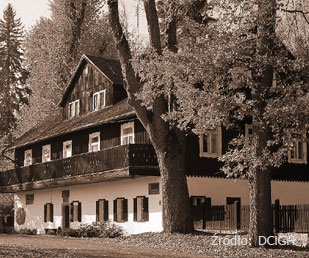 |
Gerhart and Carl Hauptmann House Bought in 1890, an old farmhouse became both a family mainstay and a place of creative work of the two outstanding writers, brothers Carl and Gerhart Hauptmanns. Gerhart Hauptmann (1862-1946) – "German father of the naturalistic drama", won the 1912 Nobel Prize in literature for his lifetime achievement; in Szklarska Poręba, he created his greatest works: "The Weavers", "The Beaver Coat", "The Driver Henschel", "Assumption of Hannele" or "Colleague Crampton". The older brother, Carl Hauptmann (1858-1921), philosopher, biologist, poet, playwright, became famous mainly for "The Book of the Mountain Spirit" which is a collection of nine adventures of the legendary ruler of the Karkonosze Mountains. From the very beginning, the Hauptmann name attracted many distinguished guests from the world of culture and science in contemporary Europe. Over time, the brothers' house became a particular place of social and artistic meetings and gave rise to the artist colony in Szklarska Poręba. Formally, the colony was formed after the death of Carl Hauptmann – in 1922, the "The St. Luke Artist Society” was founded. Today the Carl and Gerhart Hauptmann House still operates as the centre that inspires artistic movement. It organizes and participates in a number of artistic activities undertaken by culture promoters, it co-organizes open-air workshops for students, led by the Wrocław Academy of Fine Arts in association with the town authorities, it initiated the creation of the 'Nowy Młyn. Kolonia artystyczna” society, which brings together artists from the Karkonosze Mountains and the Jizera Mountains, it cooperates with EUROart – a federation of artistic colonies, to which Szklarska Poręba was admitted as a member in 2005. |
||
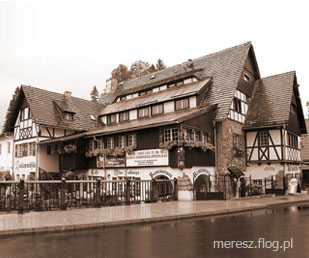 |
St. Luke Mill The St. Luke Mill is one of the oldest listed buildings in Szklarska Poręba. The building from 1870 was originally a mill, an inn and a sawmill. At the beginning of the last century, the building was devastated by fire; it was reconstructed between 1920 and 1922 under the guidance of Franz E. Schuman – municipal construction counsellor. Only the stone walls of the basement, ground floor and first floor were left from the old building. The property was then owned by Evaryst Töpfer. For the purpose of implementing refurbishment, or actually erecting a new building, the "Kunst und Gewerbehaus GmbH" company was established; its aim was also to foster the native Silesian art. The architecturally refurbished building referred to rural cottages having Upper Lusatian half-timbered and log frame structure, covered with shingles or slates. After the reconstruction, the owner made available several rooms to the group of artists, who had settled in Szklarska Poręba; they were known as the Brotherhood of St. Luke, founded by Hermann Hendrich. The first exhibition was opened on 9 September 1922. Szklarska Poreba always attracted creative people looking for inspiration for their work in the area of Mount Szrenica. That was true 100 years ago and has remained to date. Several years ago, the Nowy Młyn Society was created; it refers to the group of artists working here in the 1920s and 1930s. Currently, the St. Luke Mill is a thoroughly restored building, which offers a cosy restaurant, a disco and guest rooms. On the ground floor, the style of the restaurant's decor resembles the history of this venue. Wooden tables, a fireplace, beautifully restored ceiling highlight precious wood. |
||
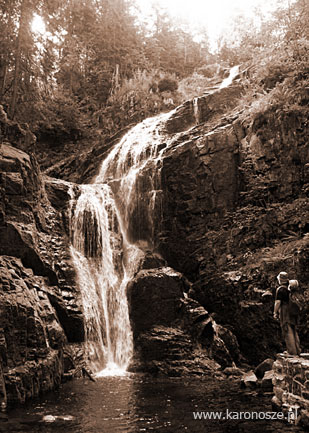
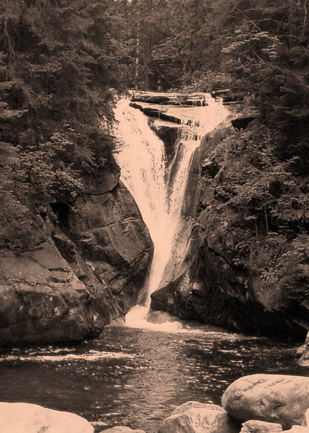 |
Kamieńczyk Waterfall is one of the most beautiful places in the Karkonosze Mountains – it is depicted in the British production "The Chronicles of Narnia: Prince Kaspian". The charm and enchanting atmosphere of the ravine with Kamieńczyk Waterfall grasped Andrew Adamson, director of the British screening of the known and valued book by C. S. Lewis. The movie producers' choice did not surprise the residents of Szklarska Poręba. In Kamieńczyk ravine, with its steep towering rock walls, the sound of water falling from above, you can feel as if we went down to the fairy-tale kingdom. Szklarka Waterfall The second highest waterfall in the Polish Karkonosze Mountains, after the Kamieńczyk Waterfall (27 m high), located at an altitude of 525 m above sea level. at a height of 13.3 m. . Dospad and its founder are a famous enclave of the Karkonosze National Park. The waterfall was first described in the Middle Ages and was often immortalized in paintings and engravings. In 1868, a general shelter "Kochanówka" was established at the waterfall. Valley of Palaces and Gardens - in the park, there are 20 castles and palaces, which were the residences of the Silesian dukes, the Prussian royal family (including the Prussian kings: William III and William IV), families belonging to the Polish, German, Czech and Austrian aristocracy and nobility, including the Radziwills, the Czartoryskis, the Schaffgotsch, the Hohenzollerns. In the construction of the buildings services the following architects were used: Karl Friedrich Schinkel, Friedrich August Stüler and landscape architect – Peter Joseph Lenné. In the nineteenth century, a complex of palaces and parks in the middle of the surrounding countryside and forest landscapes of Jelenia Góra valley, the Karkonosze Mountains and the Rudawy Janowickie mountains was created here. Approximately 0.5-hour drive from our resort, you can explore the gems of the palace architecture and landscape. |
||
| *Unsigned texts and images are taken from the portal: http://www.szklarskaporeba.pl/ |
If you want to find out about the available dates, rent a house, an apartment or if you need to obtain other information, please use our contact form. We will try to answer by email or we'll call you back. You can also call one of the phone numbers listed below.
 Address / Contact: Trzy Kultury Złoty Widok Jerzy Łaskawiec ul. Osiedle Podgórze 3, 58-580 Szklarska Poręba Mobile No. (+48) 600813763, (+48) 602415650 mail: pzge@pzge.pl Kontakt w sprawie rezerwacji: rezerwacja@trzykultury-zlotywidok.pl kom.: (+48) 600813763, Address for correspondence: ul. Kwiatowa 8, 51-252 Wrocław Account in Polish zlotys 77 1090 2398 0000 0001 3119 7874 Account in Euro IBAN - PL 61 1090 2398 0000 0001 3119 8065 SWIFT - WBKPPLPP |
Contact Form
|
|






